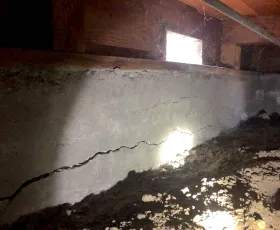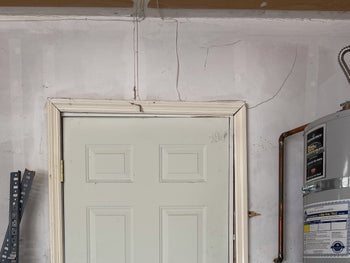Are Ceiling Cracks Serious? When To Worry?
Table of Contents
1. Are Ceiling Cracks Serious?
2. What Causes Cracks In Ceilings?
3. Types Of Ceiling Cracks
4. Ceiling Cracks: When To Worry
5. How To Repair Ceiling Cracks
So, are ceiling cracks serious? Let’s answer that by starting off with some good news…
Ceiling cracks aren’t necessarily a sign of structural damage. Yes, they can be a sign of serious structural damage but they often aren’t. It all depends on the size, type, and location of the crack.
This short article will give you basic information on the types of ceiling cracks, what causes them, and when you should contact a foundation professional.
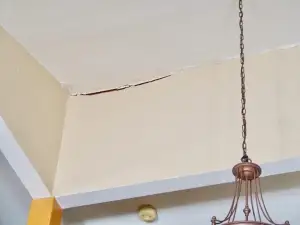
Are Ceiling Cracks Serious?
As we just pointed out, they could be. Usually, ceiling cracks are caused by one of two things: structural damage or settling (all structures settle to some extent after they’re built). If the ceiling cracks are due to normal settling, there’s usually nothing to worry about. However, if they’re caused by structural damage, you’ll need to take action and you can’t do that unless you know what to look for.
What Causes Cracks In Ceilings?
There are two main causes of ceiling cracks: Structural damage and the natural settling that happens as a building ages. Ceiling cracks can also be caused by poor workmanship.
- Your home is getting older. Do you look and feel like you did when you were ten? Well, your home doesn’t either. Normal wear and tear – which includes foundation settling – happens naturally as a building ages and can cause cracks not only in the ceiling, but wall cracks and floor cracks as well.
- You have moisture damage. Ceiling cracks can also happen because of moisture damage. The moisture might be coming from the roof or from the floor immediately above the ceiling. Did a recent powerful storm sweep through your area bringing considerable rainfall? Is there a possible plumbing leak above the cracked ceiling?
- The floor above the ceiling is too heavy. Is there something heavy in the attic or on the floor above the cracked ceiling? Bathrooms especially need ceiling support because they contain heavy items like bathtubs.
- Something is wrong with your drywall. Drywall that hasn’t been properly installed will often crack, and cracks in ceiling drywall usually aren’t serious. For example, this can happen when drywall joints aren’t properly taped. In this case, the installer doesn’t use enough drywall mud while taping the joints and as a result the tape doesn’t stick. As the tape comes loose, it causes the drywall to crack.
- You have foundation problems. Unfortunately, ceiling cracks can also be a sign of serious structural damage. For example, foundation settlement can cause ceiling cracks. This happens because foundation settlement puts stress on the building’s frame. If ceiling cracks are caused by structural damage, you need to catch them early.
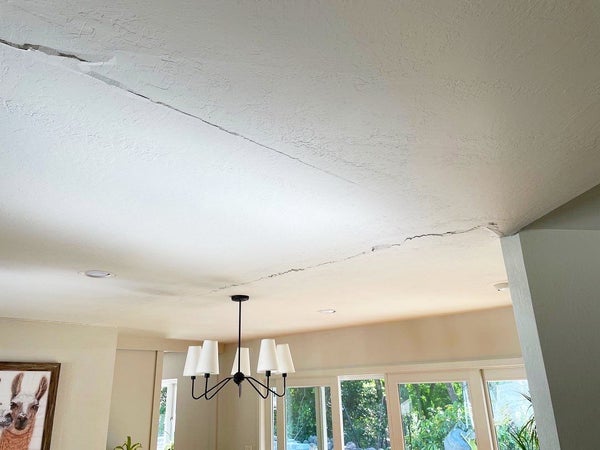
Learn more about Wall Crack Caused By A Foundation Problem.
Types Of Ceiling Cracks
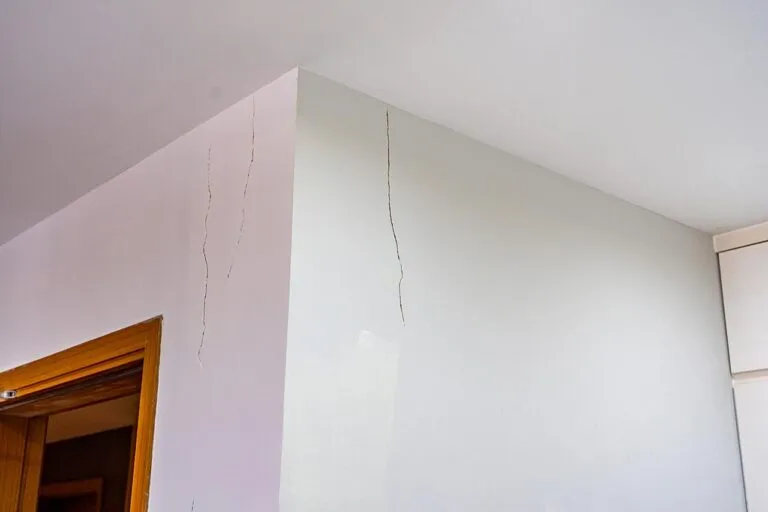
There are two main causes of ceiling cracks: Structural damage and the natural settling that happens as a building ages. Ceiling cracks can also be caused by poor workmanship.
- Thin, spiderweb cracks in the ceiling plaster or paint are probably nothing to worry about. Small cracks in ceiling plaster are normal and as we’ve just pointed out, can happen when there’s even a slight amount of natural building movement. Sometimes they’re caused by cracks in ceiling paint after years of build up. You’ll also find them on walls and floors. They usually aren’t a problem.
- Cracks that run across the ceiling and down the wall. Any crack that runs all the way across a ceiling and then down a wall is almost certainly the result of structural damage. Contact a foundation professional right away.
- Ceiling cracks accompanied by sagging. Not a good sign. Cracks accompanied by sagging need to be looked at immediately.
- Crack between wall and ceiling. If you notice a gap between your wall and ceiling, this is almost always a result of foundation settlement and should be looked at by a professional.
Ceiling Cracks: When To Worry
So, is it just a cosmetic problem associated with the structure’s age or something more serious? As we’ve been pointing out, it really depends on the size of the crack, its location, and what caused it. Here’s when you should contact a professional…
- Ceiling cracks along with sagging indicate a possible structural problem that needs immediate attention.
- One, big, continuous ceiling crack that goes across the ceiling and down a wall is almost certainly a structural issue. Contact a foundation professional right away for an inspection.
- A large number of small ceiling cracks could also indicate a serious structural problem. Contact a professional.
- If your common sense tells you there might be a serious issue. This article is meant to provide pointers, but by no means is meant to replace the value of a professional foundation inspection.
If you see any of these cracks, start looking for other signs of structural damage. This will help you determine if the cracks are serious. Signs of structural damage include…
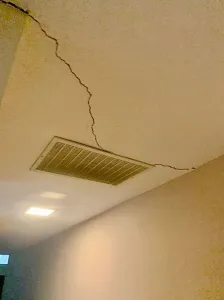
- Uneven floors that slope or sag.
- Doors and windows that stick.
- Cracks in flooring that aren’t limited to one tile. Look for cracks that go all the way across the floor in a straight line.
- Cracked or bowed walls.
- Wall rotation. This is caused by excess moisture under the foundation. As the outside edge of the foundation sinks into the soggy soil, the inside edge lifts up and causes the wall to rotate.
- Moldings that are cracked or out of place. This happens because things aren’t moving in sync.
- Stair step cracks in bricks or masonry.
- Walls that are no longer in contact with the ceiling or the floor.
- Porches or chimneys that have separated from the building.
- Water in your basement. This can be caused by cracks in the foundation wall.
Also think about whether there have been any recent earthquakes, landslides, problems with sinkholes, or anything else that could have caused structural damage.
How To Repair Ceiling Cracks
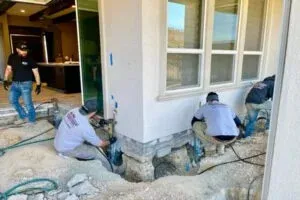
If the ceiling cracks are merely cosmetic – i.e., paint and plaster build up – you can repair them by removing the old paint or plaster and then repainting or re-plastering. However, if the ceiling cracks continue to open and you notice they may be getting bigger, this could indicate differential settlement and the home may need underpinning.
Underpinning is about extending the foundation depth so that it rests on stable soil. At Bay Area Underpinning we install galvanized steel push piers. Our most common method of lifting and stabilizing foundations that are experiencing settlement. The procedure involves installing steel brackets to the foundation and then hydraulically driving the steel piers/pipe through the brackets and into the soil under reaching load bearing strata or bedrock. Once the piers have reach load bearing strata, a synchronized hydraulic lifting system raises the house as needed. Any cracks caused by settlement can typically close up and in some cases they will not close up. It all depends on the home, and how much lift will happen when the lifting process begins and finishes.
For more information, see Underpinning A House: What Every Homeowner Needs To Know.
Conclusion
All homes – even brand new homes – settle into the soil. When this happens you will see a few small cracks appear here and there, including on the ceiling. Most of the time, these small cracks do not indicate a major structural issue. However, it’s good to know what to be on the lookout for. That way, if any serious cracks do appear, you’ll be able to spot them and take immediate action.
If you see any cracks you’re not sure about, contact a foundation professional. They’ll come out, perform an inspection, and if you do have structural damage they’ll determine what needs to be done.
If you’re in San Jose, Sacramento to Fairfield, CA, you can contact us for an inspection!
More Resources
Publish Date:
Last Modified Date:

Our Locations
2333 Courage Dr. Suite C
Fairfield, CA 94533
1161 N Fair Oaks Ave
Sunnyvale, CA 94089


